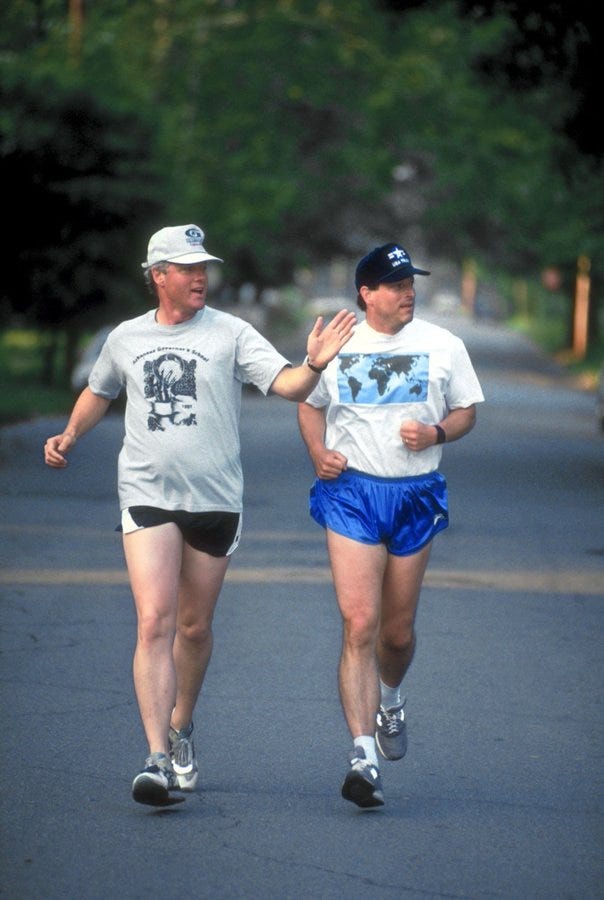Today’s edition is a walk through vice presidential selection.
How the “partnership model” created a winning formula.
The Constitution’s rules on titles and roles needed amending twice because prior editions were that flawed.
VP selection shifts to individual candidates from parties and the Electoral College (for better or worse—TBD).
You might have noticed vice presidents are having a moment.
Vice President Kamala Harris is scheduled to campaign next week with her vice presidential pick. On the Republican side, JD Vance is having a hard turn on the apprentice.
It’s hard to prove vice presidential candidates represent the difference between winning and losing elections. But the last 40 years of political history shows partnership between the candidates consistently wins the Electoral College.
Partnership: The way to win
Arguably introduced with Clinton-Gore in 1992, the partnership model allowed Democrats to rebuild themselves after three consecutive losses. These so-called New Democrats were polished problem-solvers who focussed on results and the future. They finished each other’s sentences. They demonstrated a pattern of warmth, reciprocity, and competence so powerful it broke the losing streak and remade both parties into and after the 2000 election.1
Historically, partnership was more of an afterthought. Especially in the Cold War, winning tickets expanded geography and defanged or enhanced controversial ideas and positions.
The Senate Majority Leader, Texan Lyndon Johnson, widened appeal for the young Bostonian Sen. John Kennedy and his campaign themes of missile gaps and civil rights. Before that, Gen. Dwight Eisenhower’s popularity and ideological uncertainty made the young California Sen. Richard Nixon the ideal No. 2 to define the ticket’s anti-Communism and Western appeal.
Each vice president would make history, which is not usually guaranteed for VPs.
Take Franklin Roosevelt’s VPs: He dumped the first one over the New Deal. His second VP alienated Democratic bosses with idealistic positions on labor, desegregation, and the Soviet Union. Seeing FDR approach his fourth term with his health in serious decline, party bosses sabotaged their convention to swap vice presidents. They pushed Harry Truman onto the ticket because he was moderate and predictable unlike the popular Henry Wallace. Truman set the terms for Soviet containment, the Marshall Plan, and national health insurance. Historians generally consider him among the top 10 best presidents.
In a four-way race before the Southern rebellion, Abraham Lincoln benefitted from having an anti-slavery Northerner on the ticket. Faced with a grim re-election three years into the Civil War, Republicans in 1864 rebranded as the National Union Party. The new No. 2 would be Andrew Johnson, a Southern anti-slavery Democrat (who would fumble post-war Reconstruction and rank with President Donald Trump among historians’ worst presidents).
One more real quick: A boy during Gilded Age New York, young Theodore Roosevelt was nursed on tales of swashbuckling uncles who fought in the Confederate Navy. In it’s day New York was the pivotal swing state, and Roosevelt was young and energetic. For party bosses, these were risks and pejoratives. In 1896, they “kicked up” the New York governor to sideline Roosevelt as vice president. Funny to reconsider one-half of Mount Rushmore are vice presidents.

The 25th Amendment, passed three years after the Kennedy assassination, codified the formal line of government continuity. It clarified there’s no “acting president,” which had been levied against “accidental presidents” since John Tyler in 1841. That label would also dog Theodore Roosevelt and LBJ, both of whom were presidents after assassinations.
It defined process and rules for presidential incapacity, infamously concealed by Woodrow Wilson’s wife and doctors in the final years of his term. That section, written in 1967, has gained new currency to attack contemporary presidential treachery and age.
Early days of vice and Veep
I’ve described vice presidential strengths in terms of ideology and geography. A more cynical perspective would describe VP selection as nakedly partisan self-dealing the Constitution established and protects.
In the beginning, the Electoral College simply had two votes from every state. Whoever had the most votes was president and runners up were made vice president. At the time, that worked well because everyone wanted a piece of George Washington.
When he retired, his vice president got more votes than his ex-secretary of state in the Electoral College. Things fell apart in the the revolution of 1800 where incumbent John Adams finished third behind Jefferson and Aaron Burr, who tied. The Electoral College tie would be broken in the House of Representatives.
It was Veep with monoculture and powered hair. Like moths to a flame, there was relentless hunger for power among white men who owned land. It took 36 ballots for Alexander Hamilton to peel off enough Federalists to support Jefferson over Burr.
The Burr dilemma exposed a flaw in the Constitution, which would be amended a 12th time to take roles and titling away from the Electoral College and give them to nascent political parties. While the amendment sailed through the legislature and ratification, its critics in 1804 made observations that feel clairvoyant in 2024.
Namely, the amendment solved the problem of political maneuvers with unregulated partisan procedures. It was an inadequate reform to a systemic problem of parties, and arguably, polarization. Proof for this argument would be the litany of controversial elections since then and the hundreds of proposals to modify or abolish the Electoral College.
Selecting a vice president will be Harris’s biggest decision. There are roughly 100 days until Election Day, and she has enjoyed a somewhat unexpected streak of good days—all without any political partner. That changes next week.
In another election that will have 100 or more explanations for victory and defeat, partnership between Harris and her VP, or Trump and his, will make all the difference.
I will expand on this more next week when Harris’s VP is selected.





